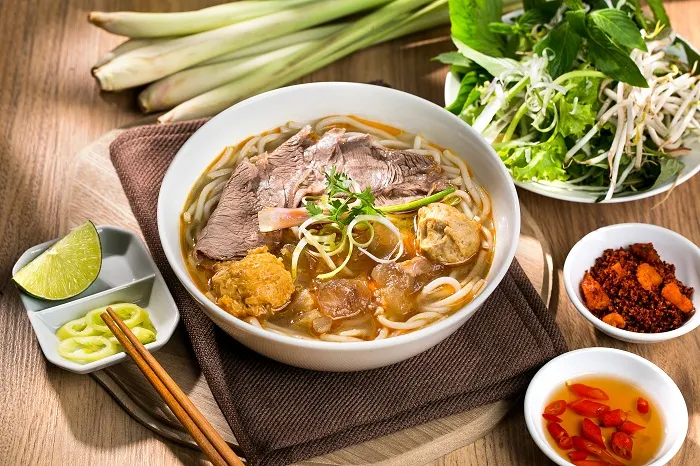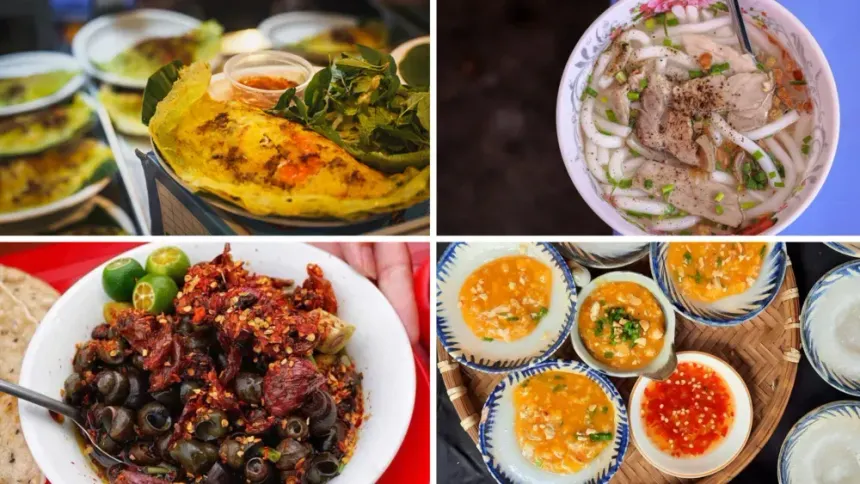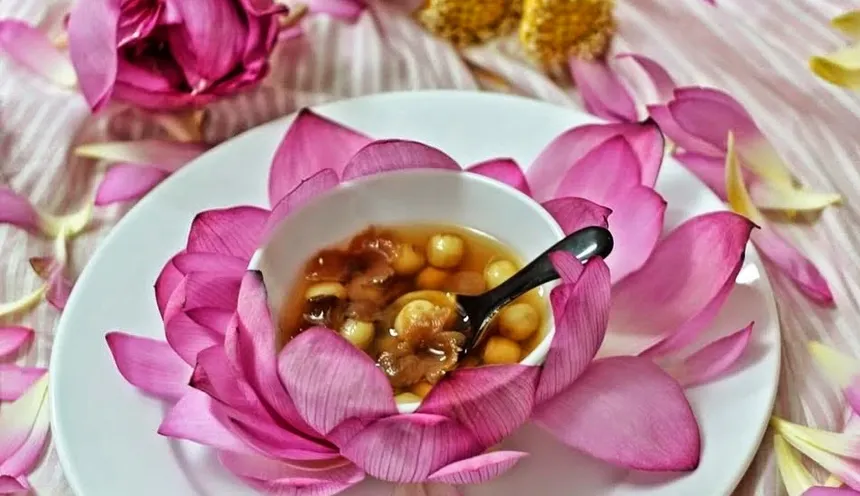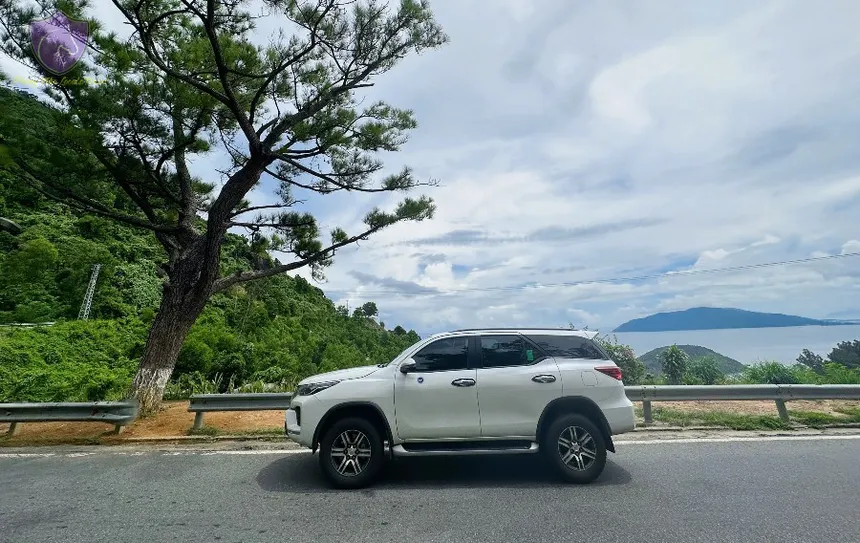Must-Try Hue Specialties: Authentic Dishes You Can’t Miss with Ovuigo
Food in Hue, Vietnam, is famed for its depth, history, and royal inspiration. When visiting, your Hue food guide should start with Bun Bo Hue, a spicy beef noodle soup. Bun Bo Hue is more robust than pho and celebrated for its lemongrass-scented broth, tender beef, pork hock, fermented shrimp paste, and plenty of chili oil. Try it at top spots like Maison Trang (Google Map, ~20,000-50,000 VND per bowl).
Another local specialty is Com Hen (baby clam rice). This dish brings together baby clams, crispy pork cracklings, roasted peanuts, rice, and a spicy-sour fish sauce. Cơm Hến 17 (Google Map, ~15,000-30,000 VND per portion) serves some of Hue’s best.
Banh Khoai is a crispy rice flour pancake stuffed with shrimp, pork, and bean sprouts, often dipped in a thick peanut sauce. Try Bánh khoái Hồng Mai (Google Map, ~40,000-70,000 VND per plate).
Nem Lui are pork skewers grilled on lemongrass stalks, wrapped with rice paper, fresh herbs, and dipped in sauce. Nem Lụi Ku Huế (Google Map, ~30,000-50,000 VND per serving) is a top spot among locals.
Do not miss Banh Beo, a delicate steamed rice cake topped with shrimp, scallion oil, crispy pork skin, and a touch of sweet fish sauce – found at many small family kitchens.
All these authentic Hue food specialties are shaped by Imperial heritage, incorporating local ingredients, regional spices, and an emphasis on intricate texture, flavor, and presentation.

Where to Eat in Hue: Best Restaurants, Street Food Stalls, and Markets
Exploring best food in Hue means balancing street food stalls with formal restaurants. The heart of Hue cuisine is found wandering Dong Ba Market (Google Map), where dozens of vendors sell Bun Bo Hue, Banh Beo, and Che Hue (sweet dessert soups) at prices ranging from 10,000 to 40,000 VND. This isn’t just food—it’s a living museum of local culture. The market opens early and buzzes until sunset.
For a sit-down meal, consider Madame Thu Restaurant – Taste of Hue or Quán Hạnh for an array of dishes in serene, royal-inspired environments. Both vegetarian and meat options are available. Madame Thu also excels at royal cuisine sets.
Those preferring casual settings can visit Cơm Hến 17 for Com Hen or any of the city’s famed Nem Lui stalls. Sip imperial tea or fresh sugar cane juice with lime, but skip the ice from street vendors if you are sensitive to water quality.
Make a detour for vegetarian cuisine at An Nhien Garden Vegetarian (Google Map), where set meals run 100,000-200,000 VND and celebrate Hue’s Buddhist influence.
Eating local food in Hue is about discovery: say yes to unfamiliar dishes, and always appreciate the presentation, often featuring dragon motifs, conical hats, and lotus garnishes—echoes of the Imperial City.

The Imperial Heritage and Royal Cuisine of Hue
Hue was the seat of the Nguyen Dynasty, Vietnam’s last royal court, imbuing its cuisine with elegance, artistry, and symbolism. Imperial cuisine stands apart—dishes like Nem Cong Cha Phuong and elaborate rice trays were crafted to delight both the palate and the eye, served in the royal halls of the Imperial City.
Royal chefs elevated simple ingredients—river vegetables, freshwater fish, and limited spices—into complex, vibrant meals. Each traditional dish in Hue adheres to the five elements of Eastern philosophy: color, taste, fragrance, shape, and nutrition. This results in elegant presentation, balanced flavors, and a preference for fresh, seasonal produce.
Today, many family restaurants and festivals recreate these royal banquets. Dine at Madame Thu or opt for an imperial feast at selected hotels or organized heritage dinners. When cooking or eating, notice small portions, lacquered chopsticks, ornate fish sauce bottles, and rice bowls adorned with phoenix or dragon motifs. These are not decorations: they represent the culinary influence of Hue’s Imperial City—where taste, presentation, ingredient, and tradition blend.

Understanding Hue’s Unique Flavors: Ingredients, Spices, and Cooking Methods
Hue’s unique dishes reflect central Vietnamese food values: minimal oil, deeply layered broths, and bold use of chili, lemongrass, and fish sauce. Rice flour shapes most traditional snacks and cakes—banh beo, banh nam, and banh loc—while fresh herbs and roasted peanuts often garnish main meals.
Broths are simmered for hours with beef bones, pork, fermented shrimp paste, lemongrass, and fiery chilies, as seen in Bun Bo Hue. Steaming and grilling trump frying, keeping meals light and healthy. Even street-food, like Nem Lui and Banh Khoai, is prepared to highlight texture and aroma.
Freshwater clams (for Com Hen) and lotus stems are regional staples. Hue’s best food to eat is both a feast for the taste buds and a display of culinary artistry. Delicate flavors—sweet, salty, spicy, sour, and bitter—are always balanced. Dishes are usually served in many small plates, encouraging diners to sample widely.

Vegetarian and Alternative Food Options in Hue
Vegetarian food options in Hue with Ovuigo are plentiful, influenced by Buddhist culture and local produce. Signature vegetarian Hue food specialties include vegetarian Bun Bo, vegetarian Banh Beo, and mushroom or tofu-based versions of imperial cakes. These rarely use dairy or eggs and frequently showcase creative plant-based broths.
Top vegetarian-friendly restaurants include An Nhien Garden Vegetarian (Google Map), Tịnh Tâm Vegan, and Thanh Liệu Vegetarian Restaurant. Meals range from 30,000 to 200,000 VND. Most local vegetarian eateries also prepare gluten-free, low-oil, and nut-free alternatives—always ask the chef if you have allergies or restrictions.
For travelers, finding authentic vegetarian Hue cuisine is easy in both markets and specialty restaurants. Dishes often include lotus seed congee, jackfruit salad, and vegetarian Nem Lui. Street vendors by Dong Ba Market or specialty eateries lining Vo Thi Sau street are reliable for consistent quality and authentic cooking.

Tips for Enjoying Hue’s Culinary Scene: Food Safety, Etiquette, and Experiences with Ovuigo
To get the most out of your Hue culinary experience, follow these steps:
- Hygiene: Choose high-traffic stalls or restaurants with visible food prep and clean cooking areas. Avoid raw greens if your stomach is sensitive, and skip ice in street beverages unless from filtered water.
- Etiquette: Practice proper chopstick etiquette—never stick chopsticks upright in a rice bowl (it’s considered bad luck). Appreciate small, beautiful presentations—a nod to Hue’s royal roots.
- Drinks: Enjoy herbal teas, sugarcane juice, or lotus tea. Refuse tap water or drinks with street ice if unsure. Popular beers and fruit juices are safe from reputable establishments.
- Culinary Experiences: Participate in the Hue Food Festival or try a local food tour for a guided journey. Many restaurants offer cooking classes where you can learn preparation methods such as steaming Banh Beo or grilling Nem Lui.
- Market Shopping: At Dong Ba Market, bargain gently and come between 8-11 AM for the best selection. Sample freely, but always wash your hands.
Remember, we don’t run tours — we craft experiences (WhatsApp +84868319161). Each journey is a story written just for you, designed for those who wish to explore Vietnam slowly, deeply, and meaningfully. No fixed itineraries. No crowds. Just you — and the moments that truly matter.
For outstanding stays in the region, consider The Manor Hoi An (airbnb.com.au/h/themanorhoian5beds), Hola 1 (airbnb.com.au/h/hola1a), and Hola 2 (airbnb.com.au/h/hola22). For more local insights and travel guides, visit ovuigo.




